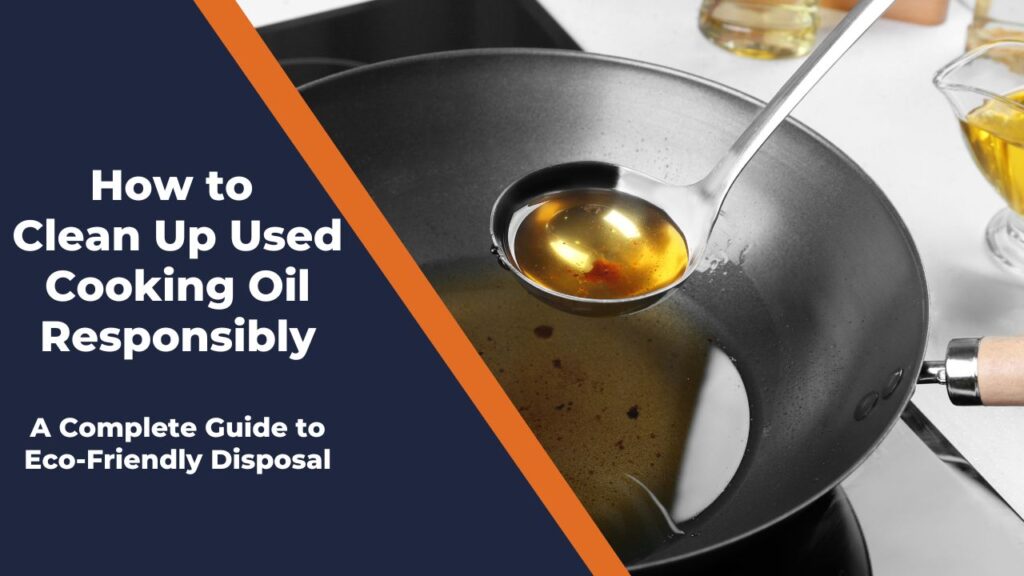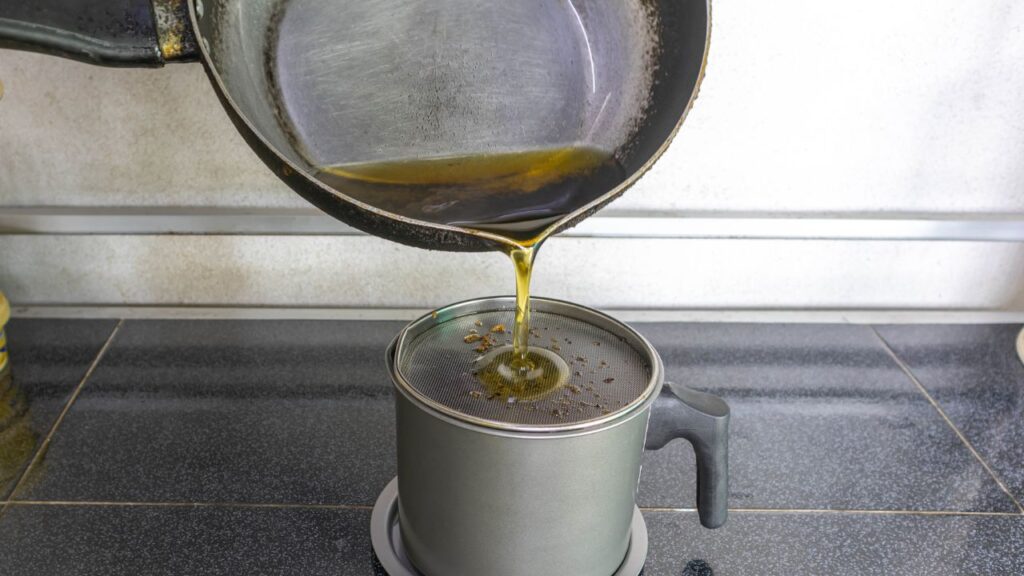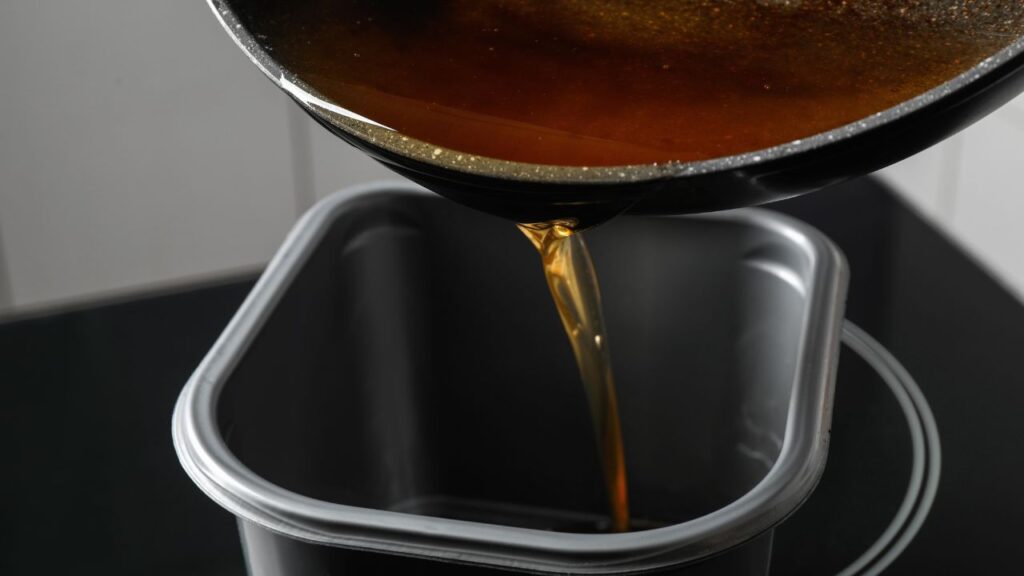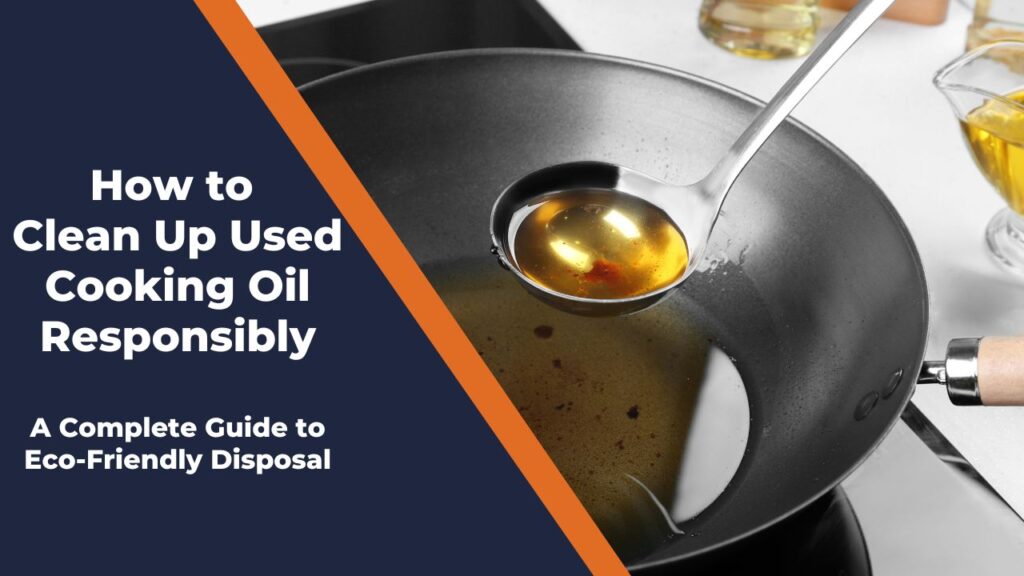
Did you know that improperly disposing of used cooking oil can clog your drains and harm the environment? How to clean up used cooking oil responsibly is a question many of us encounter, especially those keen on maintaining an eco-friendly household. Proper disposal of cooking oil not only protects your plumbing but also contributes to environmental sustainability. Let’s explore the best practices for cleaning up and disposing of used cooking oil responsibly.
Contents
- 1 Understanding Used Cooking Oil
- 2 Environmental Impact of Improper Disposal
- 3 Responsible Methods to Clean Up and Dispose of Used Cooking Oil
- 4 Step-by-Step Guide to Cleaning Up Used Cooking Oil Responsibly
- 5 Best Practices for Minimizing Used Cooking Oil Waste
- 6 Local Regulations and Resources
- 7 Comparing Different Disposal Methods
- 8 Frequently Asked Questions (FAQs)
- 9 Conclusion
Understanding Used Cooking Oil
What is Used Cooking Oil?
Used cooking oil is the oil that remains after frying, sautéing, or preparing food. Whether you’re deep-frying crispy chicken or lightly sautéing vegetables, the oil you use absorbs flavors and impurities from the food. This makes it less suitable for future cooking but still valuable if disposed of correctly.
Why Proper Disposal Matters
Proper disposal of used cooking oil is crucial for several reasons:
- Environmental Impact: Improper disposal can lead to severe environmental consequences, including water contamination and harm to wildlife.
- Household Plumbing Issues: Pouring oil down the drain can cause blockages, leading to costly plumbing repairs.
- Legal and Regulatory Considerations: Many areas have regulations regarding the disposal of cooking oil to protect public utilities and the environment.
Environmental Impact of Improper Disposal
Clogging Drains and Sewage Systems
When you pour cooking oil down the drain, it solidifies in the pipes as it cools, causing blockages. These blockages can lead to:
- Slow Drains: Minor backups can disrupt your kitchen activities.
- Severe Clogs: Major blockages can require professional plumbing services, which are both time-consuming and expensive.
- Sewage System Strain: Large amounts of oil can overwhelm municipal sewage systems, leading to environmental pollution and increased maintenance costs.
Harm to Wildlife and Ecosystems
Cooking oil can be detrimental to wildlife and ecosystems in several ways:
- Oil Spills and Water Contamination: When oil enters water bodies, it forms a film on the surface, blocking sunlight and oxygen necessary for aquatic life.
- Effects on Aquatic Life: Fish and other marine creatures can suffer from reduced mobility, reproductive issues, and even death due to oil contamination.
- Ecosystem Disruption: Oil pollution can disrupt entire ecosystems, affecting both flora and fauna.
Contribution to Pollution
Improper disposal of cooking oil also contributes to broader pollution issues:
- Greenhouse Gas Emissions: When oil decomposes in landfills, it can produce methane, a potent greenhouse gas.
- Long-Term Environmental Degradation: Persistent oil pollution can lead to soil contamination and long-term damage to natural habitats.
Responsible Methods to Clean Up and Dispose of Used Cooking Oil

Recycling Used Cooking Oil
What is Cooking Oil Recycling?
Cooking oil recycling involves collecting and processing used oil to create new products, such as biodiesel. This process not only reduces waste but also supports renewable energy initiatives.
How to Recycle at Home
- Collection Methods:
- Cool the Oil: Allow the oil to cool completely after use.
- Strain Out Food Particles: Use a fine mesh strainer or cheesecloth to remove any food remnants.
- Store Properly: Pour the strained oil into a clean, sealable container like an old plastic bottle or glass jar.
- Finding Local Recycling Centers:
- Research: Look up local recycling centers or waste management facilities that accept used cooking oil.
- Contact: Call ahead to confirm their requirements and operating hours.
- Drop-Off: Transport the collected oil to the designated recycling center.
Benefits of Recycling Cooking Oil
- Environmental Sustainability: Reduces the amount of waste sent to landfills and decreases pollution.
- Biofuel Production: Recycled oil can be converted into biodiesel, a cleaner alternative to fossil fuels.
- Economic Advantages: Supports local recycling businesses and reduces reliance on non-renewable energy sources.
Proper Disposal Techniques
Solidifying the Oil
Solidifying used cooking oil is a simple method for disposal:
- Let It Cool: Allow the oil to cool completely.
- Mix with Absorbent Materials: Combine the oil with materials like sand, kitty litter, or sawdust to solidify it.
- Dispose in Regular Trash: Once solidified, place the mixture in a sealed container or bag and dispose of it with your regular trash.
Using Oil Disposal Containers
Specialized containers can make disposal easier and safer:
- Types of Containers: Purchase containers designed for oil disposal, which are usually sealable and spill-proof.
- Safe Storage Before Disposal: Store the used oil in these containers until you can dispose of them properly, ensuring no leaks or spills occur.
Donating to Biofuel Producers
What is Biofuel?
Biofuel, particularly biodiesel, is a renewable energy source derived from organic materials like used cooking oil. It can power vehicles and machinery, reducing our dependence on fossil fuels.
How to Donate Used Oil
- Find Biofuel Producers:
- Research: Identify local companies or organizations that produce biodiesel from used cooking oil.
- Contact: Reach out to inquire about their donation process and requirements.
- Donation Process:
- Collect and Store: Gather your used cooking oil following proper collection methods.
- Arrange Drop-Off: Coordinate with the biofuel producer for the drop-off or pick-up of your donated oil.
- Benefits:
- Supports Renewable Energy: Contributes to the production of clean energy.
- Reduces Waste: Prevents oil from polluting the environment.
Utilizing Grease Traps for Larger Quantities
What are Grease Traps?
Grease traps are devices installed in kitchens to capture and separate fats, oils, and grease (FOG) from wastewater. They are particularly useful for households or businesses that generate large quantities of used cooking oil.
Installing Grease Traps in Home Kitchens
- Choose the Right Trap: Select a grease trap suitable for your kitchen’s size and oil usage.
- Installation Guide:
- Locate the Trap: Install it under the sink or near the main drain.
- Connect to Plumbing: Ensure proper connection to prevent leaks.
- Seal and Test: Make sure all seals are tight and test for proper functioning.
Maintenance and Cleaning of Grease Traps
- Regular Cleaning: Clean the grease trap periodically to remove accumulated FOG.
- Professional Services: Consider hiring a professional for thorough maintenance and to ensure compliance with local regulations.
Step-by-Step Guide to Cleaning Up Used Cooking Oil Responsibly
Collecting the Used Oil
- Let the Oil Cool: Allow the oil to cool completely after cooking to prevent burns and make handling safer.
- Strain Out Food Particles: Pour the cooled oil through a fine mesh strainer or cheesecloth to remove any food remnants. This helps in recycling or repurposing the oil.
Choosing a Disposal Method
- Recycling vs. Disposal: Decide whether to recycle the oil or dispose of it based on your local facilities and the quantity of oil you have.
- Factors to Consider:
- Volume of Oil: Large quantities are better suited for recycling or biofuel donation.
- Local Facilities: Availability of recycling centers or biofuel producers in your area.

Preparing the Oil for Disposal
- Solidifying Techniques: Mix the oil with absorbent materials if you plan to dispose of it in the trash.
- Using Containers or Bags: Pour the prepared oil into appropriate containers or disposal bags to prevent spills during transportation.
Transporting the Oil
- Safe Transportation Tips:
- Seal Containers: Ensure all containers are tightly sealed to prevent leaks.
- Secure Placement: Place containers upright in your vehicle to avoid spills.
- Protect Surroundings: Use a secondary container or old towels to catch any accidental leaks.
Final Disposal or Recycling Steps
- Dropping Off at Designated Centers: Take your collected oil to the recycling center or biofuel producer as per their guidelines.
- Scheduling Pickups: Some recycling services offer scheduled pickups for large quantities of used cooking oil. Arrange these services in advance.
Best Practices for Minimizing Used Cooking Oil Waste
Reducing Oil Usage in Cooking
- Tips for Using Less Oil:
- Use Non-Stick Pans: Requires less oil for cooking.
- Opt for Baking or Steaming: These methods often need minimal or no oil.
- Measure Oil Carefully: Use measuring spoons instead of pouring directly from the bottle.
Reusing Cooking Oil Safely
- How to Store and Reuse Oil:
- Cool Completely: Let the oil cool before storing.
- Store in a Clean Container: Use a clean, airtight container to prevent contamination.
- Label and Date: Keep track of when the oil was used to monitor its freshness.
- Signs That Oil Should Be Discarded:
- Smell: Rancid or off smells indicate the oil has gone bad.
- Color and Clarity: Darkened oil with particles is no longer suitable for reuse.
- Smoke Point: Oil that smokes at lower temperatures has degraded and should be discarded.
Composting Small Amounts of Oil
- When and How to Compost:
- Small Amounts Only: Composting is suitable for minimal quantities of used cooking oil.
- Mix with Compostable Materials: Combine oil with materials like vegetable scraps or paper towels to aid decomposition.
- Benefits and Limitations:
- Benefits: Reduces waste and enriches soil.
- Limitations: Excess oil can attract pests and create odor issues.
Educating Household Members
- Importance of Collective Responsibility: Ensure everyone in the household understands the importance of proper oil disposal.
- Sharing Disposal Practices: Educate family members on how to collect, store, and dispose of used cooking oil correctly.
Local Regulations and Resources
Understanding Local Disposal Laws
- Overview of Common Regulations:
- Prohibitions on Drain Disposal: Many areas ban pouring oil down the drain.
- Mandatory Recycling: Some regions require used cooking oil to be recycled or disposed of through specific methods.
- Consequences of Non-Compliance:
- Fines: Illegal disposal can result in hefty fines.
- Environmental Penalties: Improper disposal contributes to environmental degradation.
Finding Local Recycling Centers and Collection Services
- How to Locate Services in Your Area:
- Online Directories: Use websites like Earth911 to find nearby recycling centers.
- Local Government Resources: Check your city or county’s waste management website for information.
- Utilizing Online Resources and Directories:
- Search Engines: A simple search like “used cooking oil recycling near me” can yield useful results.
- Community Boards: Local community boards or forums may have recommendations for recycling services.
Community Programs and Initiatives
- Participating in Local Clean-Up Events:
- Environmental Groups: Join local environmental organizations that host clean-up events.
- Community Centers: Attend workshops or events focused on sustainable practices.
- Supporting Community Recycling Efforts:
- Volunteer: Help organize or participate in recycling drives.
- Promote Awareness: Share information about responsible oil disposal with friends and neighbors.
Comparing Different Disposal Methods
Comparison of Used Cooking Oil Disposal Methods
| Method | Pros | Cons |
|---|---|---|
| Recycling | Environmentally friendly, supports biofuels | May require transportation to center |
| Solidifying and Trash | Simple, no need for special facilities | Not suitable for large quantities |
| Biofuel Donation | Supports renewable energy, eco-friendly | Limited availability in some areas |
| Grease Traps | Effective for large volumes, reusable | Installation and maintenance required |
| Composting | Reduces waste, enriches soil | Only suitable for small amounts |
Steps for Each Disposal Method
| Disposal Method | Steps |
|---|---|
| Recycling | 1. Collect oil2. Store in containers3. Transport to recycling center |
| Solidifying and Trash | 1. Let oil cool2. Mix with absorbent material3. Dispose in trash |
| Biofuel Donation | 1. Collect oil2. Contact biofuel producer3. Arrange drop-off |
| Grease Traps | 1. Install trap2. Collect oil3. Clean and maintain trap regularly |
| Composting | 1. Collect small amounts2. Mix with compostable materials3. Add to compost |
Frequently Asked Questions (FAQs)
What should I do if I accidentally pour cooking oil down the drain?
If you accidentally pour oil down the drain, avoid pouring more to prevent further blockage. Use hot water and dish soap to help dissolve the oil, but if you notice slow drainage, contact a plumber to assess the situation.
Can I dispose of used cooking oil in the regular trash?
Yes, you can dispose of small amounts of used cooking oil in the regular trash by solidifying it first. However, for larger quantities, consider recycling or donating to biofuel producers to minimize environmental impact.
How can I store used cooking oil before disposal?
Store used cooking oil in a clean, sealable container such as an old plastic bottle or glass jar. Ensure the oil has cooled completely and is free from food particles to prevent leaks and spills.
Are there any eco-friendly alternatives to traditional cooking oils?
Yes, alternatives like olive oil, avocado oil, and canola oil are more sustainable choices for cooking. Additionally, consider using oils that you can easily recycle or dispose of responsibly after use.
What are the benefits of recycling used cooking oil?
Recycling used cooking oil reduces environmental pollution, supports renewable energy through biofuel production, and decreases the amount of waste sent to landfills. It also promotes sustainable practices within communities.
Conclusion
Understanding how to clean up used cooking oil responsibly is essential for maintaining both household plumbing and environmental health. By adopting eco-friendly disposal methods such as recycling, solidifying, or donating to biofuel producers, you can significantly reduce your environmental footprint. Remember to store used oil properly, educate your household, and stay informed about local regulations to ensure responsible disposal. Small changes in how you handle cooking oil can lead to substantial benefits for our planet and future generations.

